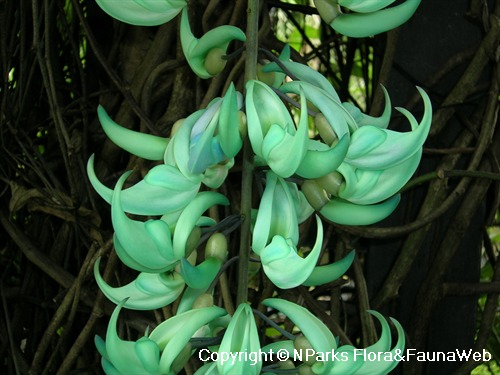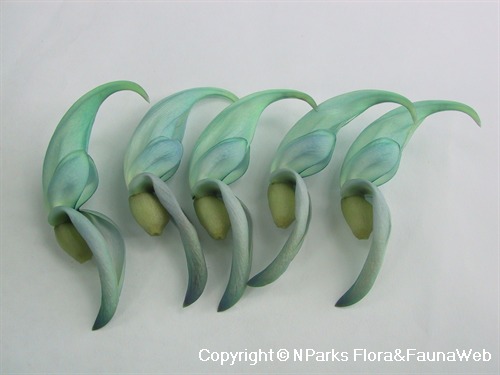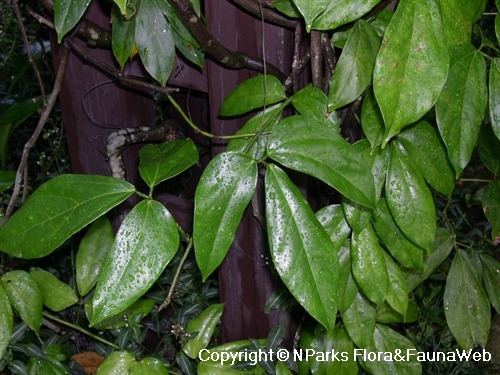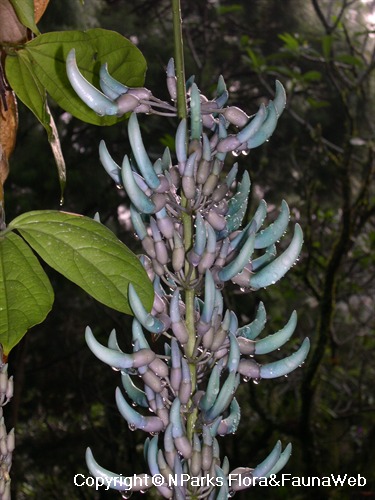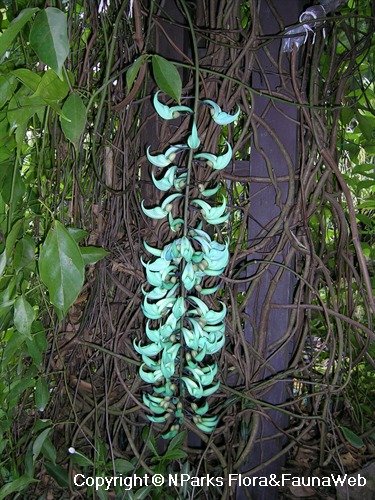.jpg)
Back
Strongylodon macrobotrys
| Family Name: | Fabaceae (Leguminosae) |
| Common Name: | Jade Vine, Jadevine, Emerald Creeper, Jade Climber |
Name
Classifications and Characteristics
| Plant Division | Angiosperms (Flowering Seed Plants) (Dicotyledon) |
|---|---|
| Plant Growth Form | Climber |
| Lifespan (in Singapore) | Perennial |
| Mode of Nutrition | Autotrophic |
| Maximum Height | 18 m |
Biogeography
| Native Distribution | Philippines |
|---|---|
| Native Habitat | Terrestrial (Primary Rainforest) |
| Preferred Climate Zone | Tropical |
Description and Ethnobotany
| Others - Plant Morphology | Growth Form: Evergreen, woody climber with twining growth habit. Habitat: Occurs in tropical rainforests, ravines and along streams. It is becoming increasingly rare in the wild due to habitat destruction and currently has a vulnerable conservation status. Stem: Woody stem has grey, smooth bark. Foliage: Light green leaves are trifoliate, consisting of 3 oblong leaflets (leaves 25 cm long, leaflets 8 - 13 cm long). Flowers: Claw-shaped flowers have a unique bluish green color (8 - 13 cm long). Flowers are arranged in long, hanging inflorescences known as pendent trusses or pseudoracemes (1.5 - 3 m long). Fruits: Fruit is a fleshy oblong or round pod (5 - 15 cm long) that has a short curly beak at the apex. It contains up to 12 light brown, oblong seeds. Landscaping: This species is planted for its unique and beautiful flowers. The vine can be trained over a trellis or pergola. Although this species flowers best when planted in the ground, it also flowers in large containers that are placed in sunny locations. Cultivation: Plant this species in fertile, well-draining soil that is slightly acidic to neutral (pH = 6 - 7). It will grow best if roots are located in a shady area, while leaves receive full sunlight. Apply a fertilizer rich in phosphorous bimonthly to promote blooming (eg., 7-9-5 NPK) at a concentration of 0.5 teaspoon per gallon of water. The stem needs to be at least 2 cm wide for flowering to occur. This species is resistant to most insects, but root diseases are likely to occur in soggy soils. Propagation: Propagate by stem cuttings or grafting. Stem cuttings will root better with bottom heat. Etymology: The species epithet "macrobotrys" is derived from the Greek words for large ("macros") and cluster ("botrys"). The reference is likely to the long, hanging inflorescences. |
|---|
Landscaping Features
| Desirable Plant Features | Ornamental Flowers |
|---|---|
| Landscape Uses | Container Planting, General, Shade Providing Tree / Palm, Focal Plant |
Fauna, Pollination and Dispersal
| Pollination Method(s) | Biotic (Fauna) (Vertebrates (Bat)) |
|---|---|
| Seed or Spore Dispersal | Abiotic (Gravity) |
Plant Care and Propagation
| Light Preference | Semi-Shade, Full Sun |
|---|---|
| Water Preference | Moderate Water |
| Plant Growth Rate | Moderate |
| Rootzone Tolerance | Fertile Loamy Soils, Well-Drained Soils, Acidic (low pH) Soils |
| Maintenance Requirements | Moderate |
| Propagation Method | Stem Cutting, Grafting |
Foliar
| Foliage Retention | Evergreen |
|---|---|
| Mature Foliage Colour(s) | Green |
| Mature Foliage Texture(s) | Glossy / Shiny |
| Foliar Type | Compound (Trifoliate) |
| Foliar Shape(s) | Non-Palm Foliage (Oblong) |
| Foliar Venation | Pinnate / Net |
| Foliar Margin | Entire |
| Foliar Apex - Tip | Rounded |
| Foliar Base | Rounded / Obtuse |
| Typical Foliar Area | Macrophyll ( 182.25cm2 - 1640.25 cm2 ) |
| Prominent Young Flush Colour(s) Remarks | Black |
Non - Foliar and Storage
| Bark Colour(s) | grey |
|---|---|
| Mature Bark Texture | Smooth |
| Stem Type & Modification | Woody |
| Root Type | Underground (Tap Root) |
Floral (Angiosperm)
| Flower & Plant Sexuality | Bisexual Flowers |
| Flower Colour(s) | Blue, Green |
|---|---|
| Flower Symmetry | Bilateral |
| Flower Size - Remarks | 6 cm wide |
| Flowering Habit | Polycarpic |
Fruit, Seed and Spore
| Mature Fruit Colour(s) | Yellow / Golden |
|---|---|
| Fruit Classification | Simple Fruit |
| Fruit Type | Fleshy Fruit |
Image Repository
Others
| Master ID | 210 |
|---|---|
| Species ID | 1506 |
| Flora Disclaimer | The information in this website has been compiled from reliable sources, such as reference works on medicinal plants. It is not a substitute for medical advice or treatment and NParks does not purport to provide any medical advice. Readers should always consult his/her physician before using or consuming a plant for medicinal purposes. |

.jpg)
